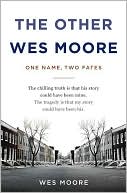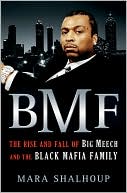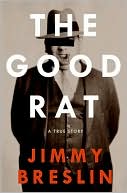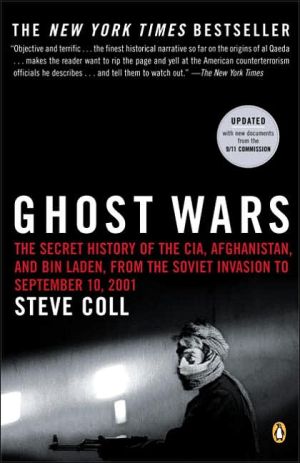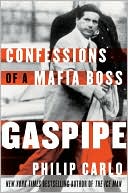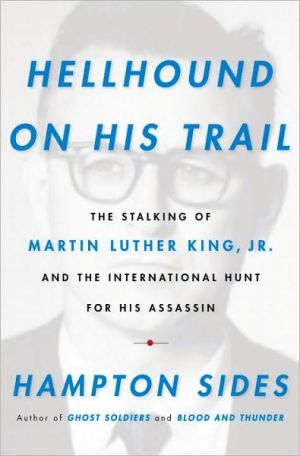The Osama bin Laden I Know: An Oral History of al Qaeda's Leader
No one knows more about Osama bin Laden than Peter Bergen. In 1997, well before the West suddenly became aware of the world's most sought-after terrorist, Bergen met with him and has followed his activities ever since.\ Today, years after President Bush swore to get him dead or alive and despite haunting the popular imagination since September 11, 2001, bin Laden remains shrouded in mystery and obscured by a barrage of facts, details and myths. With numerous never-before-published...
Search in google:
Peter L. Bergen, author of the bestselling book Holy War, Inc., offers an astounding, unparalleled portrait of Osama bin Laden, comprised of Bergen's own interviews with more than fifty people who have known bin Laden personally, from his brother-in-law to his high school English teacher to former members of al Qaeda. The resulting collage of voices and memories affords an unprecedented glimpse into the life and true nature of the man directly responsible for the largest terror attack in history. How was bin Laden transformed from a shy, polite schoolboy to commander of the world's most formidable terrorist organization? Where was he on 9/11? How did he escape from Tora Bora? Is al Qaeda a top-down organization or a loose ideological alliance? What is it about this man that draws hundreds of thousands of followers and makes men willing to fly airplanes into buildings at his command? This definitive and engaging portrait gives the American public its first true, enduring insight into a man who has declared us his greatest enemy.
Introduction\ Osama bin Laden first registered as a substantial threat within the U.S. government in January 1996 when a specialized bin Laden unit was established at the CIA. It was the first time any unit focusing on a particular individual had been set up within the agency. A year later bin Laden gave his first television interview, declaring war on the United States on CNN. Rarely have our enemies warned us so publicly of their intentions. Imagine for a minute that starting in 1937 the Japanese High Command had repeatedly publicized its goal of attacking the United States. Surely the U.S. Navy would then have been more prepared for the Japanese attack on Pearl Harbor on December 7, 1941.\ Within four years of bin Laden's interview on CNN, al Qaeda had carried out the bombings of two U.S. embassies in Africa, an attack on the USS Cole in Yemen, and the 9/11 attacks, inflicting more direct damage on the United States than the Soviet Union had done during the nearly five decades of the Cold War. To a large degree, this exponentially increasing campaign of violence was the result of the vision of one man: Osama bin Laden.\ Just as an account of Nazism and its impact on Europe would be nonsensical without reference to the persona and worldview of Hitler, or a history of France after the Revolution of 1789 would make no sense without an understanding of the goals and personality of Napoleon, so too our understanding of al Qaeda and the ideology it has spawned would be incoherent without reference to Osama bin Laden's personal story and his view of the world.\ Despite bin Laden's importance to the al Qaeda organization and to the larger ideological movement it has spawned, the conventional wisdom now is that tracking bin Laden down won't make much of a difference to the larger war on terrorism. At a March 2002 press conference, President George W. Bush referred to bin Laden as "a person who's now been marginalized." Some have even joked that bin Laden is, in fact, Bin Forgotten. Although it is certainly the case that the global jihadist movement will carry on whatever bin Laden's fate, it would be dangerously wrong to assume that it doesn't really matter whether or not he is apprehended.\ Finding bin Laden remains of utmost importance for two reasons: First, every day that bin Laden remains at liberty is a propaganda victory for al Qaeda. Second, although bin Laden and his deputy Ayman al Zawahiri don't exert day-to-day control over al Qaeda, they do continue to supply broad strategic guidance for the group's actions and for those of its affiliates. Statements from bin Laden and al Zawahiri have always been the most reliable guide to the future actions of jihadist movements around the world. This has remained the case even while both men have been on the run. Indeed, since the 9/11 attacks, bin Laden has released at least eighteen statements on video or audiotape, which have reached audiences of tens of millions as those statements are relayed around the globe by the BBC, CNN, Al Jazeera, and other television networks.\ Arresting the spread of bin Laden's ideas will prove more problematic than arresting or killing al Qaeda's leaders. One indicator of this is a worldwide opinion poll undertaken by the Pew Global Attitudes Project in March 2004. The Pew poll found that bin Laden is viewed favorably by large percentages in Pakistan (65 percent), Jordan (55 percent), and Morocco (45 percent), all key allies in the war on terrorism. The results of the 2004 Pew poll are similar to a 2003 Pew poll in which Indonesians, Jordanians, Pakistanis, and Moroccans all expressed more "confidence" in bin Laden than in President Bush, by large pluralities. Indeed, not since Egypt's president Gamal Abdel Nasser galvanized the Middle East in the 1950s and 1960s with his vision of Arab nationalism married to socialism has an Arab political figure had as much impact on the world. An indicator of bin Laden's continued ideological importance to the militant jihadists is that in 2004 the most feared insurgent commander in Iraq, Abu Musab al Zarqawi, pledged his allegiance to al Qaeda's leader.\ Given the impact that bin Laden has had on the recent history of the world, there is surprisingly a good deal that remains mysterious about him. For instance, how did he develop into the leader of the world's most deadly terrorist organization? How did he conceive of the religious-political ideology that will be his legacy? Is he a rich, wannabe jihadist who became the pawn of Egyptian Islamist militants, or is he his own man? To what extent has al Qaeda functioned as a top-down organization run by bin Laden, and to what extent has it always been more of a loose ideological movement? Is bin Laden's fight against the West the petulant act of a quixotic millionaire, or the carefully thought-out strategy of a man who believes he is fighting for the very survival of true Islam? Is he attacking the United States because of its freedoms or its foreign policies? Finally, what does bin Laden really want: the overthrow of the Saudi regime, or the restoration of the caliphate across the Muslim world?\ I do not pretend that this book will definitively answer all those questions. After all, the interior life of any person is something of a mystery. And writing about bin Laden is complicated by the fact that he grew up in one of the most closed societies on the planet, the Kingdom of Saudi Arabia, and is himself a scion of one of the kingdom's most secretive families. Moreover, he has seemingly deliberately avoided revealing much of his personal story when he has been interviewed. However, I hope I have elicited, through scores of interviews and a search of many archives and databases, something that will help the reader develop a fuller picture of the man and his organization.\ My intent is not to perform an exercise of what the French term Tout comprendre, c'est tout pardonner (To understand everything is to forgive everything). What bin Laden has done is unforgivable. But bin Laden is a man and we need to understand him neither through a fog of our own propaganda — he has never, for instance, expressed an interest in attacking the West because of our "freedoms" — nor through the mythomania of his supporters, who style him as the defender of Islam, despite the fact that the Koran is full of injunctions against the killing of civilians. As you read this book, maybe bin Laden will remain forever a sphinx without a riddle, an enigmatic smile playing on his lips, or perhaps he will emerge as something fuller.\ In an effort to try to fill in some of the information gaps about bin Laden, I decided to write an oral and document-based history of al Qaeda's leader using the words of those who have some personal insights about him, whether through one chance meeting, or years of deep friendship. Everyone quoted in this book, with a few exceptions that are noted in the text, has actually met bin Laden, thus ensuring that their stories are firsthand accounts and are filtered neither through the recollections of others nor through the tsunami of nonsense that has been written about him, such as the assertion that as a teenager he was partying in Beirut, or that al Qaeda had an alliance with Iraq's former leader, Saddam Hussein.\ My decision to limit the people we hear from in this book to those who have met bin Laden is something of a device, but I believe it is a useful one. The fact that someone has actually encountered bin Laden is an indicator that the person probably has something insightful to say about bin Laden himself or al Qaeda's roots, history, and future. Of course, this book is not a series of dozens of accounts of someone's first meeting with bin Laden, which would become boring quickly. Rather, the meeting with bin Laden is, in most cases, simply a launching point for a wider discussion of bin Laden's character, the personalities of his inner circle, and al Qaeda's history and goals.\ I hope this history of bin Laden will illuminate worlds of which the reader is likely to have little experience — for instance, the time and place where bin Laden grew up — Jeddah, Saudi Arabia, in the seventies; where al Qaeda slowly took shape — Afghanistan during the Soviet war in the eighties; where bin Laden became more radicalized — Sudan in the mid-nineties; also, Afghanistan under the Taliban in the late nineties; and, finally, the secretive world of al Qaeda itself.\ To tell the stories in this book I have relied on interviews I have conducted over the past eight years in Afghanistan, Pakistan, Saudi Arabia, Jordan, Egypt, Yemen, and the United Kingdom. I have also incorporated testimony given by people who know bin Laden in legal cases in the United States, Canada, Italy, France, Bosnia, Belgium, Spain, Germany, and Egypt. Finally I have mined books written by al Qaeda's leaders and former Taliban officials; thousands of pages of transcripts of U.S. military tribunal proceedings for prisoners held at Guantánamo Bay; firsthand accounts of bin Laden from newspapers around the Muslim world; documents from the Saudi BinLadin Group; and a trove of al Qaeda-related documents and publications going back to the mid-eighties that I have collected.\ A key discovery among those al Qaeda-related publications was several thousand pages of Jihad magazine, which was the in-house organ of the Arab jihadists based in Pakistan during the 1980s. West Point's Combating Terrorism Center also made available its translation of thousands of pages of the Encyclopedia of Jihad, al Qaeda's vast internal training manual that was largely written during the 1990s. I have also used statements from bin Laden himself, such as those he made to me and to CNN's Peter Arnett in March 1997 when we interviewed him in Afghanistan for his first television interview, the only time that I met al Qaeda's leader.\ The personal detail that most forcefully struck me when we met bin Laden was how he presented himself as a soft-spoken cleric, rather than as the fire-breathing leader of a global terrorist organization. During the course of our interview, bin Laden's tirade against the West was delivered in a voice that barely rose above a whisper. It was also clear that bin Laden was well informed about world events. He mentioned, for instance, that the former IRA terrorist leader Gerry Adams had recently met with President Clinton at the White House. This off-the-cuff comment, made in the middle of the night in a hut on a cold Afghan mountaintop, has always stayed with me as an example of bin Laden's intense interest in world politics. It's these kinds of insights and anecdotes about bin Laden that I hoped to elicit in my interviews with those who have spent time with him. At the same time I also wanted to derive a better account, from the inside, of the nature of the al Qaeda organization.\ As I was gathering interviews and material for this book, I realized one theme had started emerging rather forcibly: The whole history of al Qaeda, much of Afghanistan's history over the past two decades, and even the events of 9/11 itself, reflect in part the ideological and military struggles between bin Laden and the legendary Afghan commander, Ahmad Shah Massoud. Not only was there personal enmity between the two men, but they are also both representive of the ideological civil war that is taking place today in the Muslim world between those who, like bin Laden, want to install Taliban-style theocracies from Indonesia to Morocco, and those who, like Massoud, aim to create Islamic states that enjoy friendly relations with the West, are tolerant of other religions, and are amenable to women having a role outside the home.\ In 1993 during Afghanistan's civil war I met Massoud at his headquarters north of Kabul and, like so many others, I was struck by his intense integrity and charisma. Massoud was arguably the most brilliant military strategist of the late twentieth century, surviving six major Soviet operations during the eighties aimed at defeating him in his sanctuary in the Panjshir Valley in northern Afghanistan. Yet in person Massoud projected a kind of gentle fragility and a disarming sense of humor. The experience of meeting Massoud was quite a powerful sensation and was very different from the experience of meeting bin Laden, whom I found opaque and hard to read.\ Massoud and bin Laden never met, but as one of the interviewees in this book perceptively observes, if they had done so, the recent history of the world might well have turned out differently. While Massoud was what most Westerners would term a fundamentalist, his was a moderate kind of fundamentalism, which was leavened by an interest in the poetry and mysticism of Sufism, tolerance for others, and an orientation towards the West. Beginning in the late eighties, bin Laden and the Egyptians who would form the core of al Qaeda began to turn against Massoud as they embraced a more highly radicalized Islamism that branded Muslims who did not share their militant jihadism as "apostates."\ Beginning in the late eighties, al Qaeda allied itself with Massoud's bitter rival, the Afghan commander Gulbuddin Hekmatyar. And in the late nineties al Qaeda also joined forces with the Taliban, which faced its only serious opposition from Massoud's forces. Massoud had resisted the Taliban for more than five years. The story of the enmity between bin Laden and Massoud climaxed with Massoud's assassination on September 9, 2001, which historians will record as the curtain-raiser for the 9/11 attacks two days later. The assassination was personally ordered by bin Laden. It was a gratuity to the Taliban leader Mullah Omar, whom bin Laden did not clue in on his 9/11 plans, which Mullah Omar would have likely opposed on the grounds that such an act would threaten his regime.\ Another theme that emerged as I was reporting this book is the extent to which bin Laden acts on impulse, often overreaching and paying little attention to the potential consequences of his actions. In some cases this trait might indicate decisiveness. Most of the time it indicates foolhardiness and egotism. Bin Laden, for instance, did not wait for a fatwa to be issued about the necessity of fighting the Soviets when they invaded Afghanistan on December 25, 1979. At the age of twenty-two, bin Laden went to Pakistan within weeks of the invasion and started fund-raising for the Afghan war effort. While other Arabs involved in the jihad against the Soviets saw it as their mission to play a supporting role to the Afghan mujahideen, between 1986 and 1987 bin Laden set up his own entirely Arab military force. That force took on the Soviets at the battle of Jaji in the spring of 1987.\ However, while the Arab military engagement at the Jaji battle, much like the 9/11 attacks a decade and a half later, brought a great deal of publicity to bin Laden, neither turned out to be smart strategy. Which brings us to an important point: Bin Laden certainly attempts to think strategically. For instance when he created his Arab force that would not retreat from the Soviets, or later when he attacked the "far enemy" the United States, in an effort to destabilize the "near enemy" Saudi Arabia. But what are the fruits of his strategic thinking? The battle of Jaji showed the Arabs could hold off a larger number of Soviets for a period of a few weeks. Nothing more. September 11 showed that al Qaeda could attack the United States itself, but it turned out to be something of a kamikaze mission for bin Laden's organization, as the American response to the attacks was to decimate al Qaeda and destroy its Taliban partners.\ Similarly, in 1989 bin Laden insisted on participating in the attack on the city of Jalalabad in eastern Afghanistan, despite the fact that such an attack did not play to the strengths of his small guerrilla army. The attack turned out to be a fiasco, and around one hundred of his Arab mujahideen were killed. And against the advice of several of his associates, as the war against the Soviets was winding down, bin Laden set up his own organization to continue fighting jihads around the world: al Qaeda.\ Bin Laden continued to act impulsively after the war against the Soviets. When Saddam Hussein invaded Kuwait in 1990, bin Laden immediately offered to set up his own mujahideen force to defeat the Iraqis, an idea the Saudi government dismissed out of hand. After 1996, while bin Laden was based in Afghanistan, he gave interviews to several international media organizations calling for attacks on the United States, despite the fact that the Taliban had repeatedly put him on notice not to do so. And then, of course, he presided over the 9/11 attacks, which had the unintended effect of obliterating the Taliban regime and destroying al Qaeda's extensive infrastructure in Afghanistan.\ Perhaps because we constantly hear that Islamist terrorists are bound together by their common dislike of the United States, we tend to assume that they must also be united by common tactics, strategies, and ideology. In fact, they often resent one another as much as they do the Bush administration, and the global jihadist movement is split by squabbles over personnel and strategy. That is another key theme I hope emerges from this book: how fissured and split the jihadist movement has been historically — and how those fissures became even more pronounced as a result of the 9/11 attack, which many Islamist militants have concluded did damage to their cause.\ *\ I have tried to exclude materials from the book that are either of questionable authenticity or impossible to verify. There is, for instance, a marvelous gossipy interview with bin Laden's fifth wife, a Yemeni, that was published in the Saudi Majallah magazine in 2002. The article claimed that bin Laden's former wife had returned to Yemen from Afghanistan after the fall of the Taliban, a claim that is dismissed by Abu Jandal, bin Laden's chief bodyguard, who has proved a reliable source of information about al Qaeda's leader.\ Likewise, a lengthy screed, which first surfaced in November 2002, "Osama bin Laden's Letter to America," purports to be from al Qaeda's leader. The letter decries everything about the United States, from its stance on global warming to its supposed toleration of incest.5 However, it is dismissed as a fake by those familiar with bin Laden's style, such as the Palestinian journalist Jamal Ismail, who has known al Qaeda's leader since 1984. It is also my judgment that the letter is not from bin Laden, as it rants on about a number of issues, such as AIDS, gambling, and the American sex trade, which bin Laden has never discussed in any of his scores of other statements. Moreover, unlike a bin Laden audiotape or videotape, a letter posted on a Web site claiming to be from al Qaeda's leader, as this one was, cannot be independently verified.\ Obviously, some of the people I am quoting in the book may have self-serving versions of events, and some may even be lying. Where that is the case readers should be able to detect it, either because of the circumstances in which those statements were made, or because of information supplied by other interviewees elsewhere in the book. Clearly a detainee held at Guantánamo is likely to put an innocent gloss on his activities, for example, while former officials in the Sudanese government may have developed amnesia about the close relations they enjoyed with bin Laden during his four-year sojourn in Sudan.\ *\ I have excerpted a variety of documents in this book. They are generally from court proceedings around the world, but there are also a myriad of other sources, such as U.S. State Department cables, and books written by al Qaeda insiders. In the interests of clarity and narrative flow I have generally edited these down, and I have not added ellipses to those edited texts so as not to clutter the book further. I have followed a similar procedure with statements made by bin Laden and Ayman al Zawahiri. For those readers who wish to consult the original documents and statements, the footnotes are a road map to where those can be found.\ In some cases those documents and statements are available on the Internet. Others are less accessible, but in all cases the original source is indicated.\ Where an interview in the book was conducted by a news organization, such as the Al Quds al Arabi newspaper, that is made clear on first reference, and then it is footnoted if the interview appears again later in the book. The rest of the interviews in the book were largely conducted by me, and details of the dates and places of those interviews can be found in the footnotes. Interviews undertaken by three people who helped me research the book — Paul Cruickshank, Sam Dealey, and James Meek — are similarly footnoted. (Note that some interviewees chose to speak in English, their second language.)\ Arabic names have been transliterated in a manner that is the most standard for Western readers. Thus, I have used Osama bin Laden and al Qaeda rather than Usama bin Ladin and al Qaida. I have also used the spelling Binladin when referring to the family construction business, as this is how it generally appears in English. In the case of references to Arabic names that appear in official documents that are written in English, I have retained the original spelling that was used in the document.\ I have tried to be as accurate as possible about dates, cross-referencing the dates of events offered by interviewees in the book either with other people's accounts of the same event or with contemporary documents where that is possible. In the course of reporting this book I noticed, however, that because of the differences between the Western and Islamic calendars, sometimes interviewees in the Muslim world made mistakes when transposing dates between the two calendars. Additionally, because fundamentalist Muslims do not celebrate birthdays, it is hard, particularly in Saudi Arabia, to be absolutely certain about a person's birth date in the same manner that one can be in the West. With those caveats, I have endeavored to make the dates in the book as accurate as is possible.\ Copyright © 2006 by Peter L. Bergen
\ \ 1\ Arabia\ 1\ \ \ 2\ The Afghan war\ 24\ \ \ 3\ From donor to holy warrior\ 49\ \ \ 4\ The birth of al Qaeda\ 74\ \ \ 5\ Al Qaeda goes global\ 108\ \ \ 6\ Afghanistan, again\ 160\ \ \ 7\ Al Qaeda attacks\ 219\ \ \ 8\ The charismatic leader\ 258\ \ \ 9\ The 9/11 plot\ 283\ \ \ 10\ The fall of the Taliban and the flight to Tora Bora\ 311\ \ \ 11\ Al Qaeda's quest for weapons of mass destruction\ 337\ \ \ 12\ How al Qaeda took root in Iraq and the story of Abu Musab al Zarqawi\ 350\ \ \ 13\ Bin Laden on the run\ 369\ \ \ 14\ Bin Laden's legacy\ 382\ \ \ App. A\ Where are they now?\ 395\ \ \ App. B\ Osama bin Laden's immediate family\ 399\ \ \ App. C\ The BinLadin family business\ 404\ \
\ From Barnes & NobleWhen Peter Bergen first met with Osama bin Laden in 1997, the Saudi terrorist was not yet even a speck in the world's eye. In the years since their introduction, Bergen has interviewed more 50 people who know bin Laden personally. This oral history presents this still relatively youthful "world's most wanted man" in his multiple personae: as a friendly, soft-spoken, even witty raconteur and as a resolute, fervent jihadist warrior.\ \ \ \ \ Richard A. ClarkeBergen, the author of the bestselling Holy War, Inc. (2001), has made a fresh contribution here by unearthing often obscure first-person accounts, attempting to establish their credibility and providing bridging and scene-setting narratives that link them together. Although these accounts are often self-serving and may be inaccurate, they still produce a far more detailed picture of bin Laden than the one that emerges from more conventional biographies.\ — The Washington Post\ \ \ Foreign AffairsBergen, author of the acclaimed Holy War, Inc.: Inside the Secret World of Osama bin Laden, has pieced together the accounts of over 50 people who have known bin Laden to construct a narrative of the man and his deeds. His sources include the Englishman who was bin Laden's teacher in an elite Saudi prep school, a boyhood friend, bin Laden's bodyguard, the few reporters of different nationalities who have interviewed him, and, most prominently, several intimate followers (and a few opponents) of bin Laden from across the Arab and Muslim world. The many different accounts, introduced with just enough commentary by Bergen to clarify the context, reveal the role of other individuals important to the bin Laden story as well, including Ayman al-Zawahiri and "the Blind Sheik," Omar Abdel Rahman. Such a collection of primary sources might have produced no more than a source book, but Bergen has made of it a coherent and indeed dramatic account. How appropriate that the short biographies of those cited are gathered under the rubric "Dramatis Personae." This is a compelling story well told. There is plenty of evil, but thanks to Bergen's ability to bring out the human dimensions of the individuals involved, the banality of evil is not lacking either.\ \ \ \ \ Library JournalSince the terrorist attacks of 9/11, Osama bin Laden, the mastermind and leader of al Qaeda, has become a household name. Yet few people know many facts about this elusive figure. Bergen (terrorism analyst, CNN; Holy War, Inc.: Inside the Secret World of Osama bin Laden) has reported on al Qaeda for more than a decade. In his latest book, by means of transcribed recollections of numerous people whose lives have intersected with bin Laden's, Bergen provides an authoritative, accessible, and fascinating account of the man for Western audiences. Those defining him through their memories include bin Laden's relatives, close friends, and associates. Bergen has written an introduction as well as connecting text presenting the various "speakers" who contribute details to the portrait. The reader comes away understanding the genesis and development of al Qaeda's philosophy and with new insights into bin Laden's life, such as the early manifestations of his religious fervor and the actual minutes of his founding meeting of al Qaeda in 1988. The book's attention to the post-9/11 period is especially useful. Bergen correctly concludes that although 9/11 may have been a tactical victory for al Qaeda, it has now turned into a strategic defeat for that organization. It is the Iraq war that has given al Qaeda new life. Highly recommended for all public and academic libraries.-Nader Entessar, Spring Hill Coll., Mobile, AL Copyright 2005 Reed Business Information.\ \ \ \ \ Kirkus ReviewsHe was a nice, quiet boy, a loner, kept pretty much to himself. Then he got a little funny in the head-but we never saw it coming. So suggests Osama bin Laden's high-school English teacher, remembering him as "extraordinarily courteous . . . probably partly because he was a bit shyer than most of the other students." From shy teenager to world-renowned criminal: The career arc that CNN correspondent Bergen's oral history describes surely seemed unlikely to the wealthy Saudis among whom bin Laden came of age, though all the signs were there; a neighbor, for instance, recalls that though bin Laden was fond of Westerns and kung-fu movies, he was also a priggish fundamentalist who dreamed of liberating Palestine and chided his siblings for ogling the maid and wearing short-sleeve shirts. He translated that fundamentalist drive into military action by funding and fighting alongside the anti-Soviet mujahedeen of Afghanistan, though he later made the "odd" decision to form the predominantly Arab force called al Qaeda. The accounts of his fellow soldiers and of veterans of al Qaeda, some taken from trial transcripts and intelligence reports, point to bin Laden as something of a failure as a strategist; his closest friend from university chided him in Afghanistan for his willingness to spend his soldiers' lives, saying, "You can throw away the Koran, but not drop the blood of a person," while even al Qaeda members characterized him as "a madman from a mental hospital, a madman but a genius." All recent accounts agree, however, that bin Laden outfoxed his American pursuers in post-9/11 Afghanistan and is very much alive, though he will gladly fight to the death as a martyr for Islam: "I am just apoor slave of God," he told Al-Jazeera. "If I live or die, the war will continue."Know your enemy, the adage goes. This is a most helpful resource. First serial to Vanity Fair\ \

